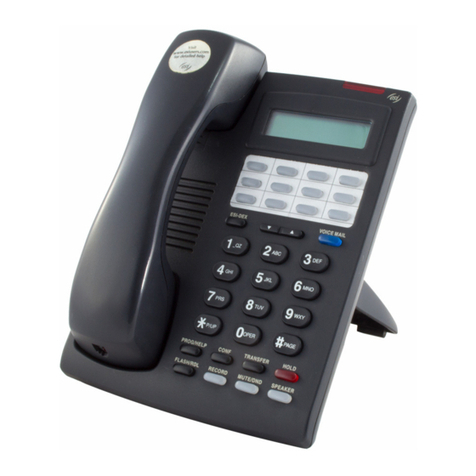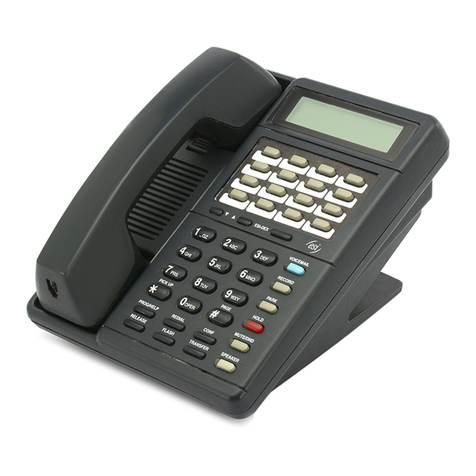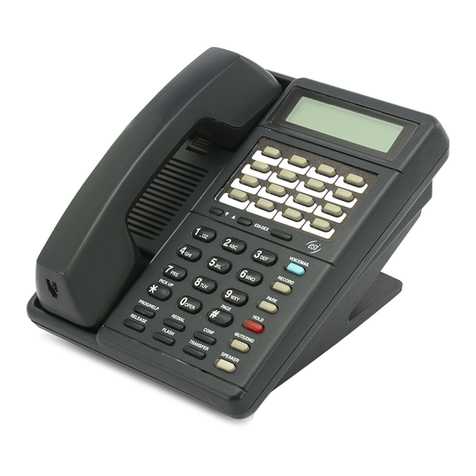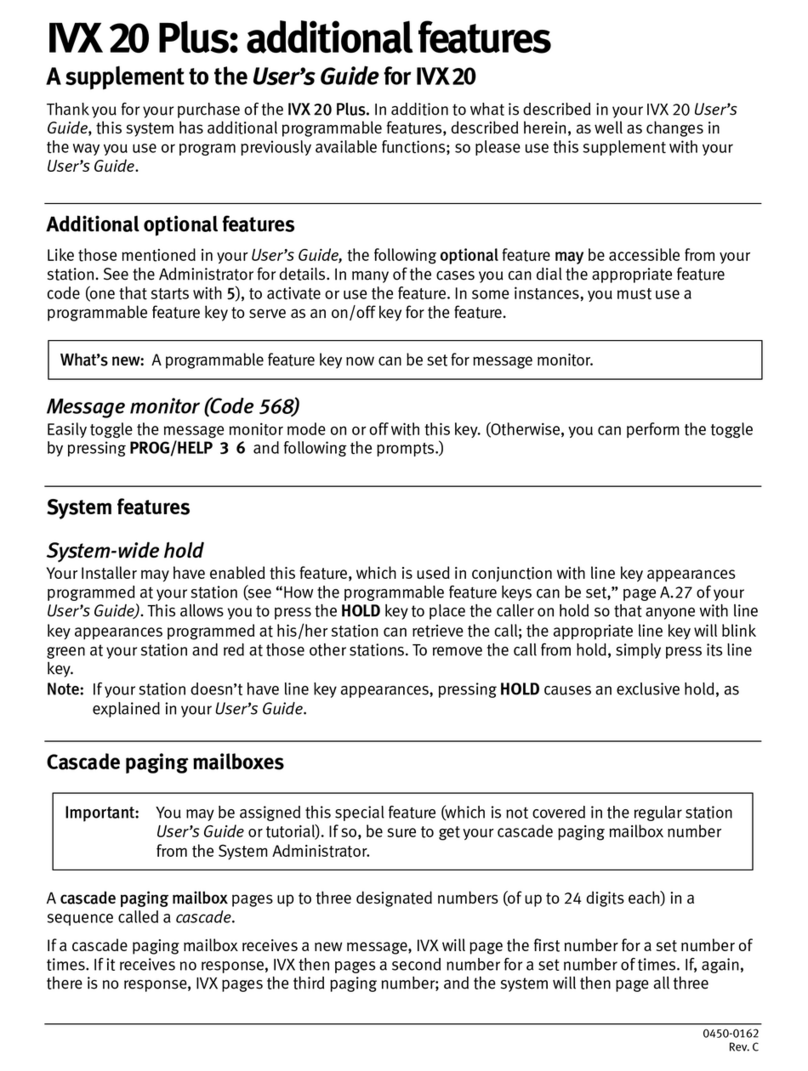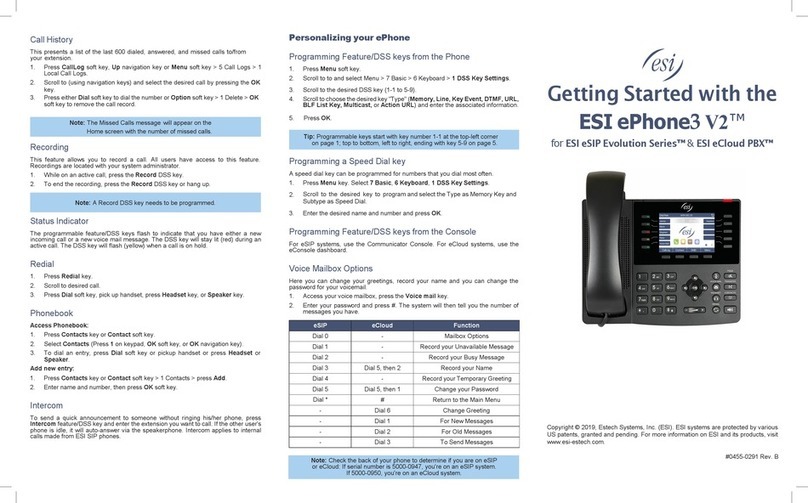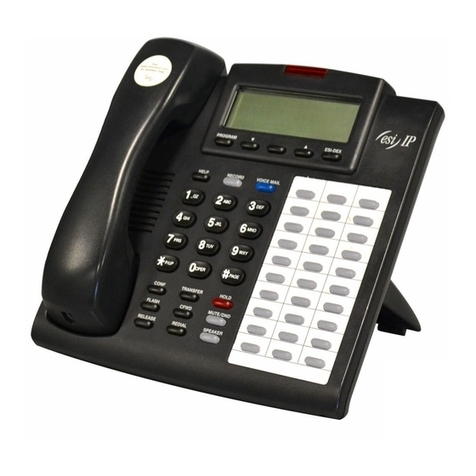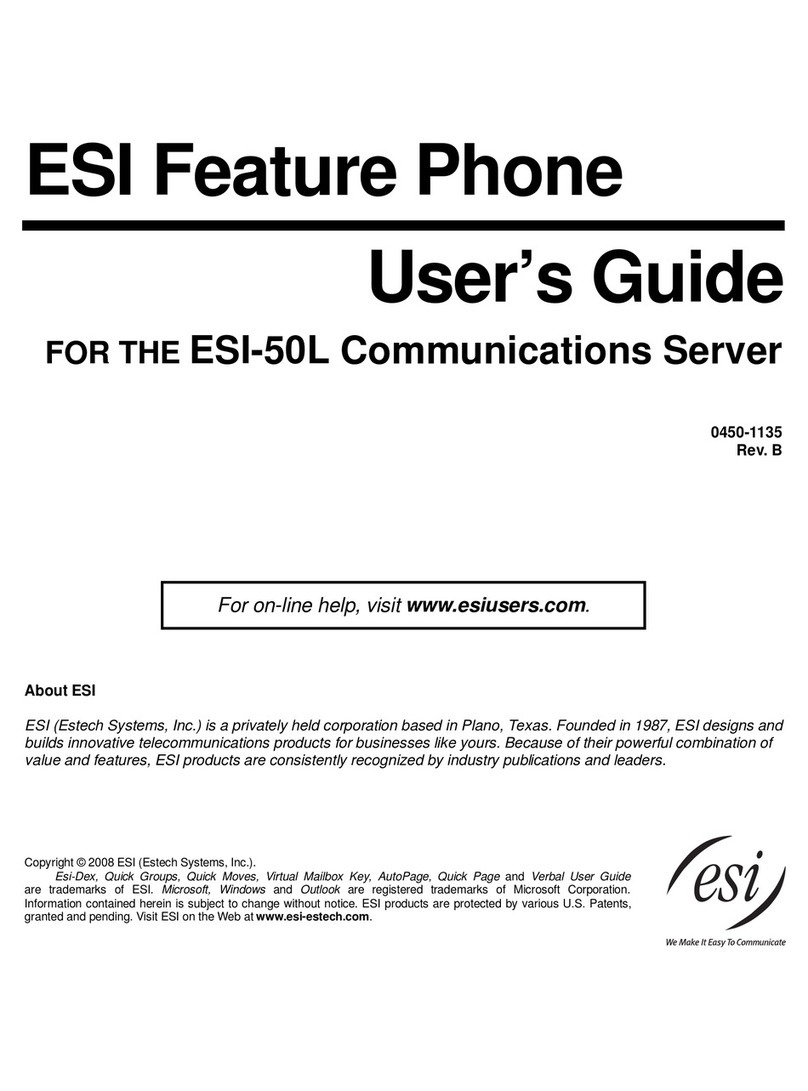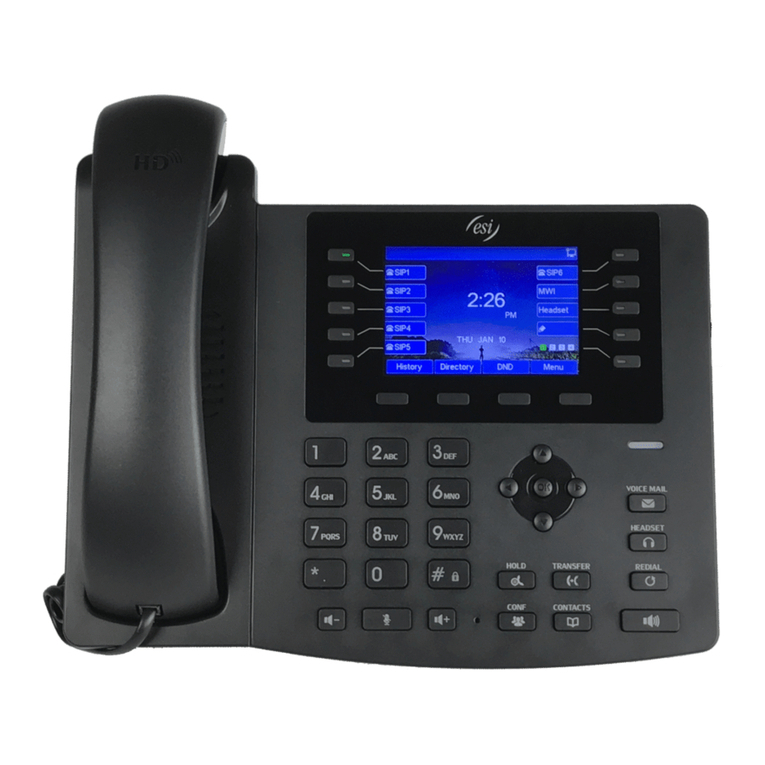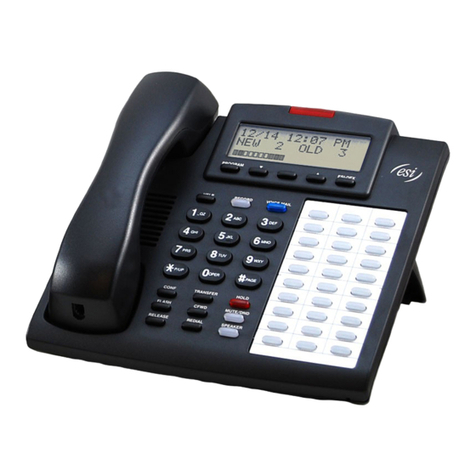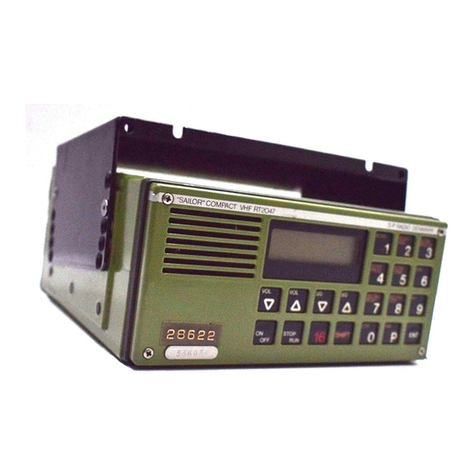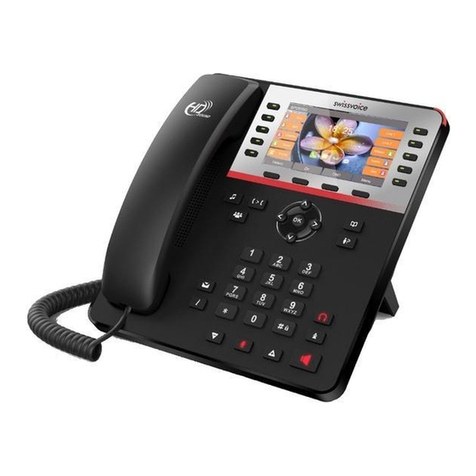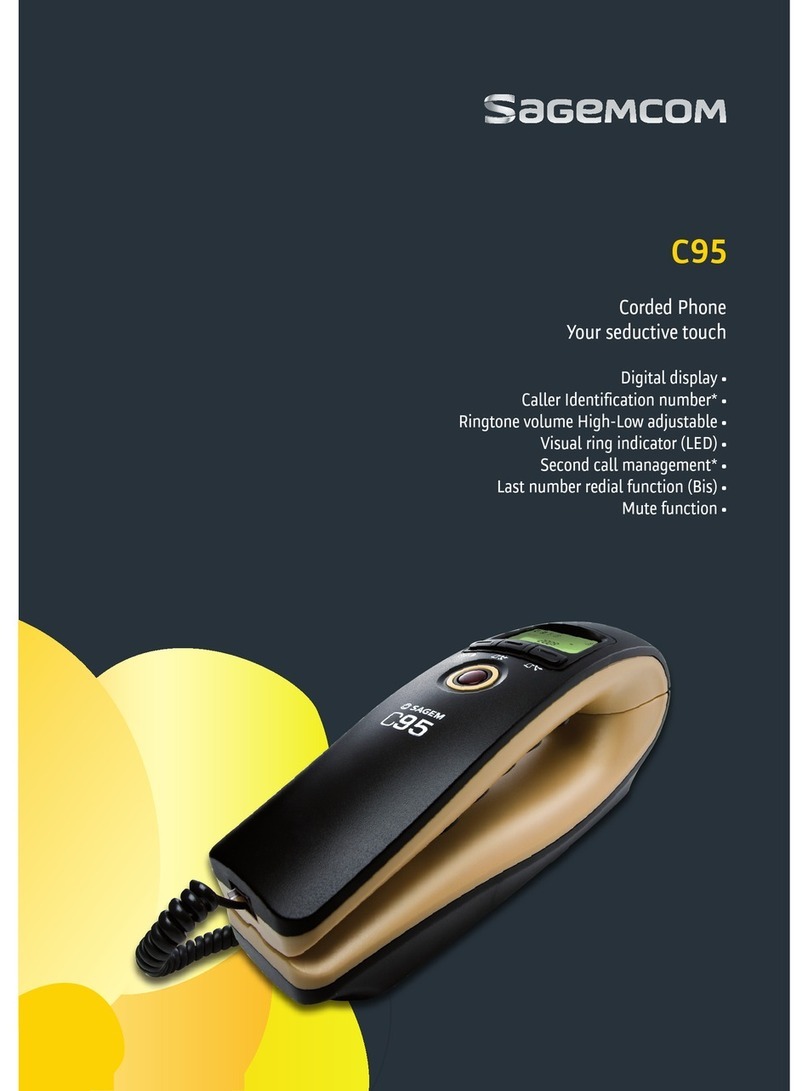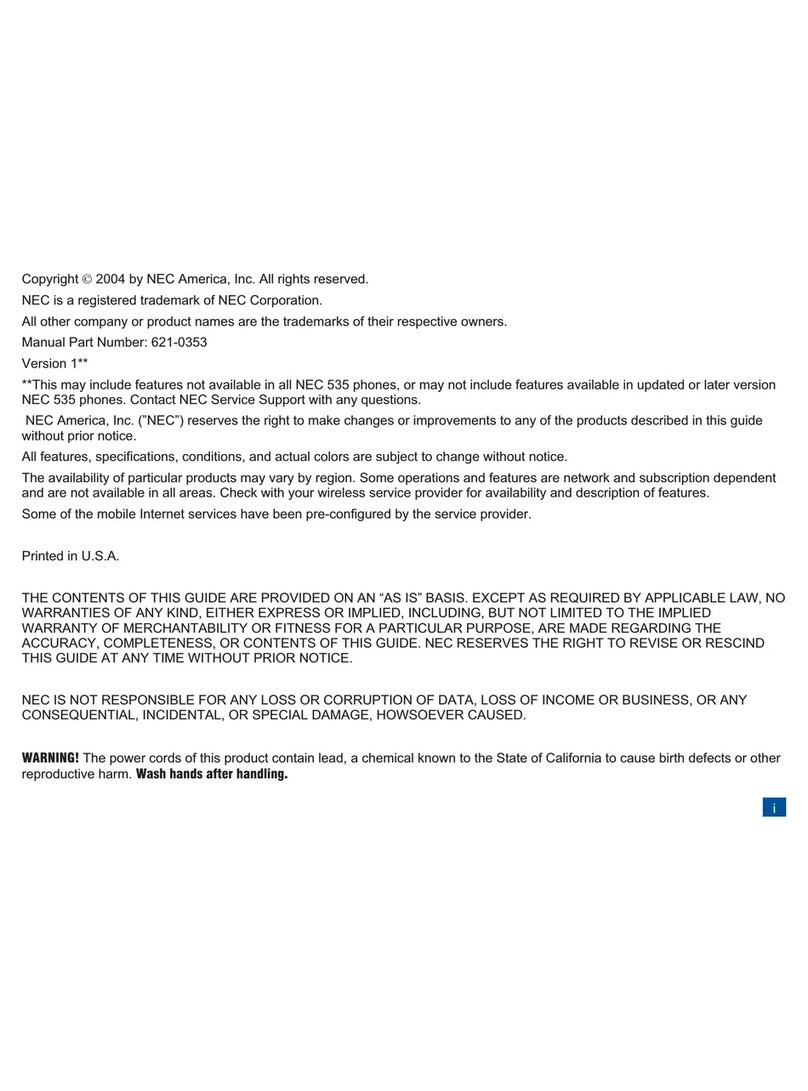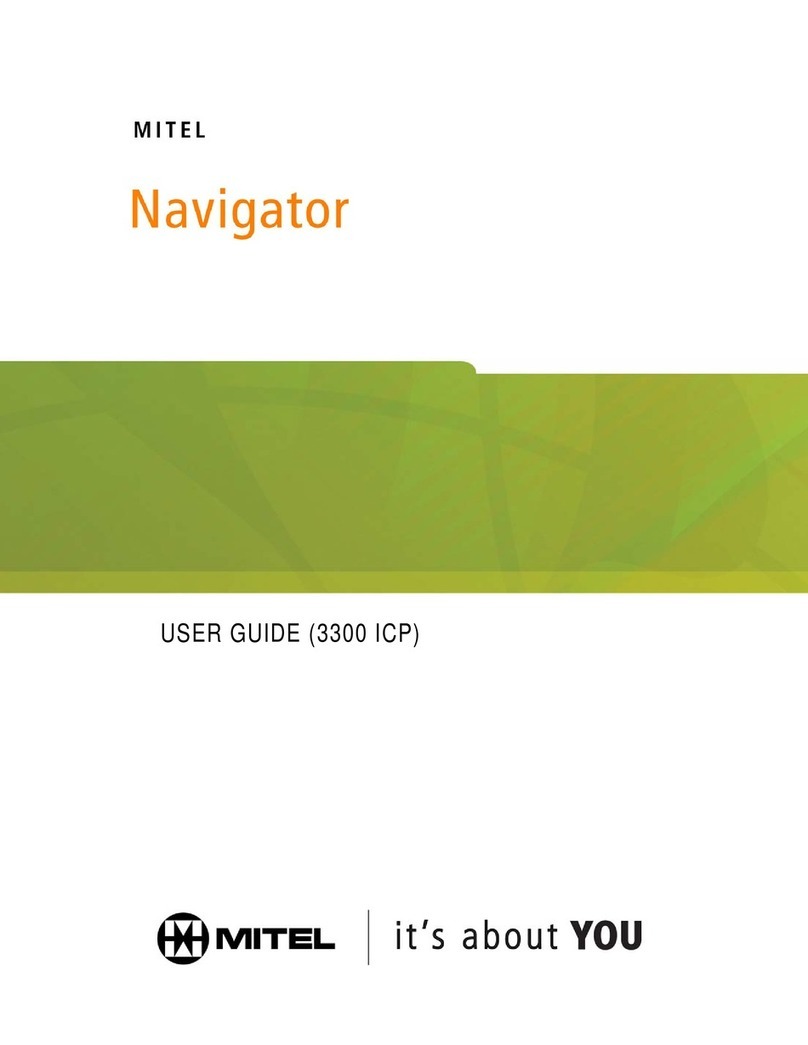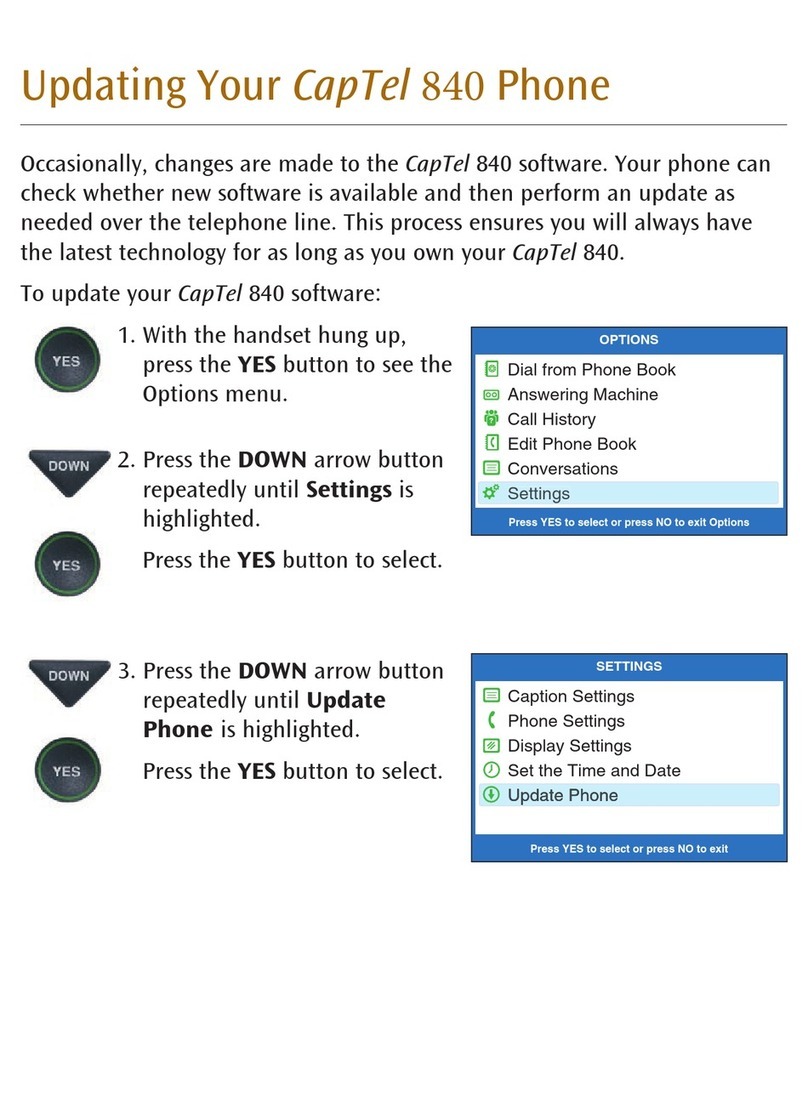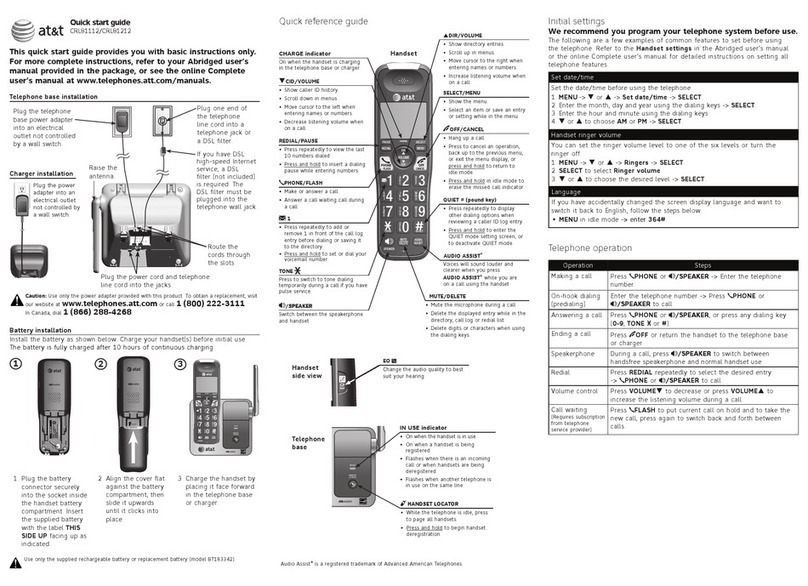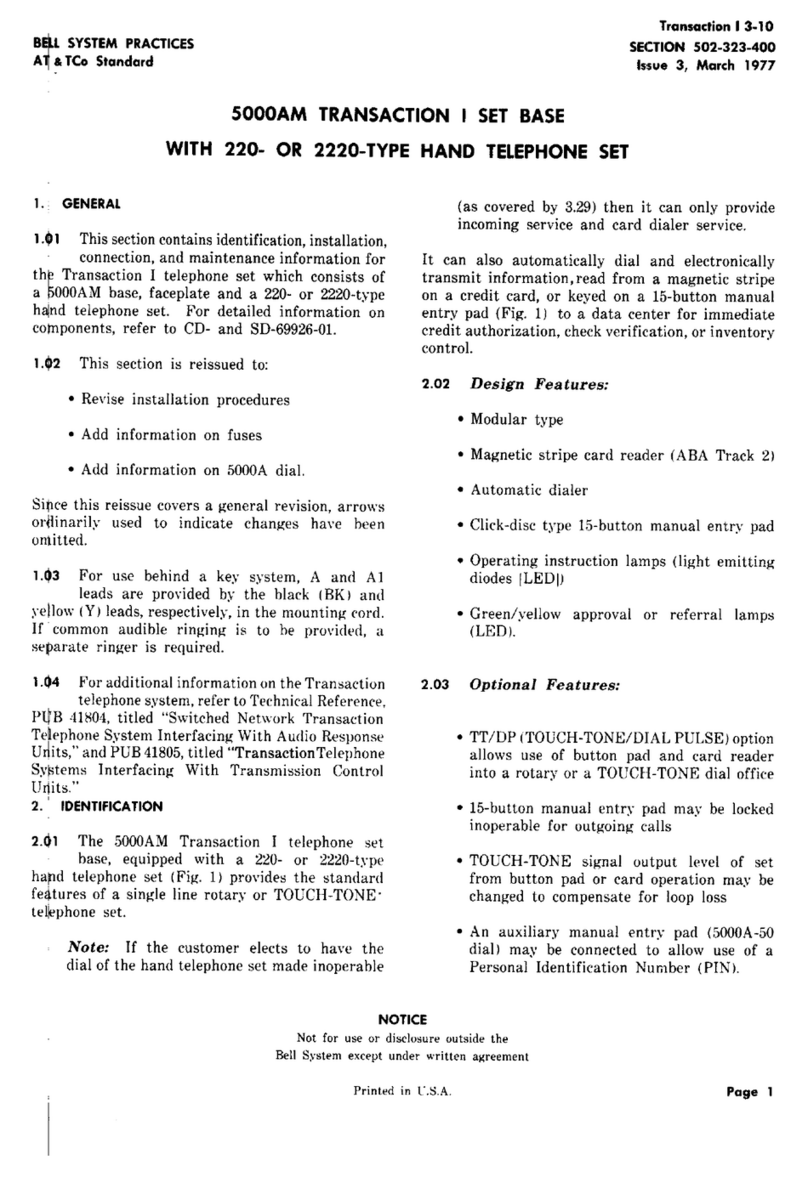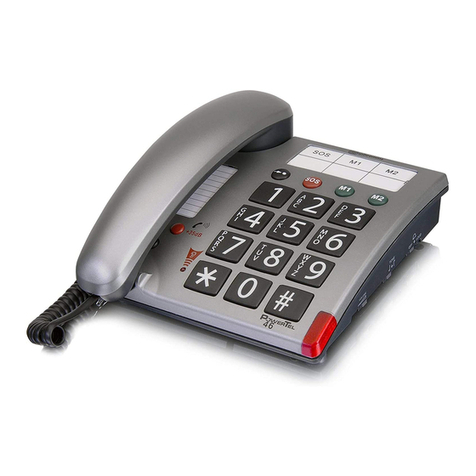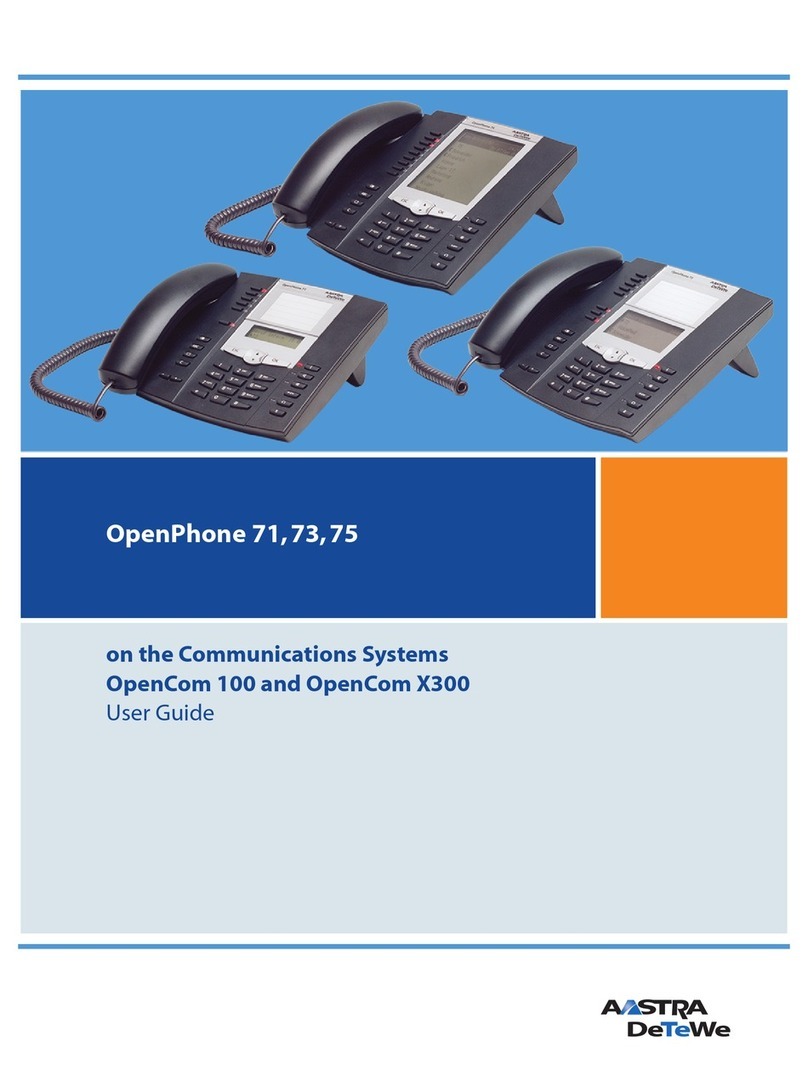ESI 24-Key Feature Phone User manual

ESI Feature Phone
User’s Guide
FOR
0450-0512
Rev. B
Visit http://www.esiusers.com for up-to-date help.

About ESI
ESI (Estech Systems, Inc.) is a privately held corporation based in Plano, Texas, near the internationally
known “Telecom Corridor.” Founded in 1987, ESI designs and builds innovative telecommunications
products for businesses like yours. Because of their powerful combination of value and features,
ESI products are consistently recognized by industry publications and leaders.
Copyright © 2005 ESI (Estech Systems, Inc.).
Visit ESI on the Web at http://www.esi-estech.com.
Microsoft is a registered trademark of Microsoft Corporation.Intel is a registered trademark of Intel Corporation. Certain ESI products are protected by
various U.S. Patents, grantedand pending. Product information contained herein is subject tochange without notice. ESI is an ISO 9001:2000-
certified company.

Table of contents
Introduction...............................................................................................................................................................A.1
24-Key Feature Phone ................................................................................................................................................................................A.2
12-Key Feature Phone ................................................................................................................................................................................A.3
Connecting your ESI phone........................................................................................................................................................................A.4
Help mode (Verbal User Guide)..............................................................................................................................B.1
User programming: An introduction......................................................................................................................C.1
User programming menu ............................................................................................................................................................................C.1
ESI Feature Phone operation..................................................................................................................................D.1
Display...........................................................................................................................................................................................................D.1
Status indicator lamp....................................................................................................................................................................................D.1
Caller ID ........................................................................................................................................................................................................D.1
Keys...............................................................................................................................................................................................................D.2
Dial tone........................................................................................................................................................................................................D.3
Basic phone use...........................................................................................................................................................................................D.4
Direct station selection.................................................................................................................................................................................D.4
Transferring an outside call to another station...........................................................................................................................................D.5
Conferencecalling .......................................................................................................................................................................................D.6
Call forwarding..............................................................................................................................................................................................D.7
Call waiting....................................................................................................................................................................................................D.7
Hold/exclusive hold operation .....................................................................................................................................................................D.8
Paging........................................................................................................................................................................................................ D.10
Call pickup.................................................................................................................................................................................................. D.10
Optional feature......................................................................................................................................................................................... D.10
Special keys..............................................................................................................................................................E.1
FLASH, REDIAL, RELEASE......................................................................................................................................................................E.1
Esi-Dex..........................................................................................................................................................................................................E.1
Override ring.................................................................................................................................................................................................E.5
Headset operation........................................................................................................................................................................................E.5
Outside dial tone preference.......................................................................................................................................................................E.5
Line keys.......................................................................................................................................................................................................E.6
Optional features..........................................................................................................................................................................................E.6
Analog stations.........................................................................................................................................................F.1
Caller ID ........................................................................................................................................................................................................F.1
Placing calls..................................................................................................................................................................................................F.1
Transferring outside calls.............................................................................................................................................................................F.1
Call forwarding..............................................................................................................................................................................................F.1
Call waiting....................................................................................................................................................................................................F.2
Call hold ........................................................................................................................................................................................................F.2
Paging...........................................................................................................................................................................................................F.2
Call pick-up...................................................................................................................................................................................................F.2
Index

(This page included for pagination purposes only.)

User’s Guide Introduction
A.1
Introduction
Accessing the rich ESI feature set is simple and easy through the straightforward design of ESI’s
Feature Phones. Each feature has been designed for ease of use while providing capabilities needed in
an advanced business phone.
You will be able to learn many of the features by simply using your phone; and this User’s Guide will
introduce you to the wide variety of features offered by your ESI phone system and how to use your
phone effectively to achieve maximum benefits.
What it covers
• 24-Key Feature Phone
• 12-Key Feature Phone
• Analog phone operation
How it’s arranged
• Section A — Introduction and phone illustrations
• Section B — User help
• Section C — User programming
• Section D — Phone operation
• Section E — Special keys and features
• Section F — Analog stations
• Index

Introduction User’s Guide
A.2
24-Key Feature Phone
The 24-Key Feature Phone has a variety of programmable and built-in features. The 24-Key Feature
Phone’s built-in voice prompts make it easy to program and use.
Hint: You can perform direct programming by holding down a programmable feature key for at least
two seconds (similar to how you might program a car radio button). This isn’t applicable to the
fixed feature keys.
2-line, 32-character display
ESI-DEX feature key
(pg. E.1)
PROG/HELP
feature key
for phone programming
as well as access
to Verbal User’s Guide
and tutorial (pg. B.1)
Volume/scroll keys
12 programmable feature
keys (pg. C.1)
Microphone for
built-in speakerphone
Speaker
Fxed feature keys
(pg. D.2)
VOICE MAIL and
RECORD keys
(non-functional
when used with
this phone system)
Status indicator light (pg. D.1)
PAGE key (pg. D.10)
P/UP (pickup) key
(pg. D.10)

User’s Guide Introduction
A.3
12-Key Feature Phone
The 12-Key Feature Phone includes the basic, most commonly used phone features.
Notes: The following features are not available on the 12-Key Feature Phone.
Certain special features; see page E.6.
Esi-Dex.
A CONFERENCE key and MUTE/DND key must be set on one of the nine programmable feature keys
to utilize those features.
Hint: You can perform direct programming by holding down a programmable feature key for at least
two seconds (similar to how you might program a car radio button). This isn’t applicable to the
fixed feature keys.
1-line,
16-character display
Volume/scroll keys
9 programmable
feature keys
Speaker
Fxed feature keys
(pg. D.2)
PAGE key (pg. D.10)
P/UP (pickup) key
(pg. D.10)
PROG/HELP
feature key
for phone programming
as well as access
to Verbal User’s Guide
and tutorial (pg. B.1)

Introduction User’s Guide
A.4
Connecting your ESI phone
Use the diagram (below) to connect your ESI phone. The diagram represents the panel on the
phone’s underside.
Note: The “Top of phone” and “Bottom of phone” references in this diagram shows the correct vertical
orientation of the phone — i.e., the part with the display is the top.
12-Key Feature Phone
24-Key Feature Phone
• Connects like a basic phone.
• Handset plugs into right-side jack.
• Line cord plugs into left-side jack.
Line cord
to wall
Handset

User’s Guide Help mode (Verbal User Guide)
B.1
Help mode (Verbal User Guide)
Your ESI phone system’s Help mode (also called the Verbal User Guide) — a carefully conceived
combination of spoken information, display readouts and even key illumination when appropriate — is a
powerful tool to help you learn how to use the system’s many features.
Tutorial
When your station is idle, press PROG/HELP, and then follow the spoken Help menu to:
• Learn how to use the phone
• Hear a description of how any key is used
• Hear a complete tutorial on phone operation
Help during station programming
To hear a detailed description of a function you wish to program, press PROG/HELP while programming
it.
Help during a call
Press PROG/HELP while on a call and this will place the call on hold, whereupon you can use Help
mode to hear a description of the function you wish to perform. When you exit Help mode, you will be
reconnected to the call.
While you are either in Help mode or programming your phone, your station will be temporarily placed
in DND (see “MUTE/DND,” page D.3). Anyone calling your station while you are in DND will be
disconnected after four minutes.
Exiting Help mode
To exit Help mode, simply hang up.
Visit www.esiusers.com for up-to-date help.

Help mode (Verbal User Guide) User’s Guide
B.2
(This page included for pagination purposes only.)

User’s Guide User programming: An introduction
C.1
User programming: An introduction
Voice prompts will play menu and sub-menu options to access the desired feature. You don't have to wait
for the entire prompt to be played. Therefore, once you’ve become familiar with the prompts (see “User
programming menu,” below), you can quickly set any frequently used feature.
Programming help
During any of the programming steps, press PROG/HELP to hear a more detailed description of the
feature and related programming options.
Exiting programming mode
To exit programming mode, simply hang up.
User programming menu
Overview
2 Programmable feature keys
(Station keys, line keys, speed-dial keys, other feature keys)
3 Station options
1 Call waiting/background announce
3 Headset operation
4 Outside dial tone preference
5 Hands-free answer
4 Station audibles
1 Station ring tone
2 Station ring volume
Note: Background announce, and selections 3 and 5 under station options,are notavailable on a 12-Key
Feature Phone.
2 Programmable feature keys
There are two methods for programming your phone:
• Direct programming — Select the key you want to program, and hold it down for at least two
seconds.This not only initiates programming but also lets you immediately program that specific key.
• Traditional programming — Press PROG/HELP. The Verbal User Guide will speak to you,
walking you through the full menu, during which you can choose the appropriate option.
Direct programming example:
You wish to set one of the keys to dial a co-worker, whose extension is 105. Hold down the
key for at least two seconds. This automatically puts you in feature key programming. Follow
the prompts to enter 1 0 5. (This has allowed you to skip two steps — pressing PROG/HELP
and selecting a menu option — that you’d have had to perform if using traditional
programming.)

User programming: An introduction User’s Guide
C.2
How the programmable feature keys can be set
• Line keys — If a line number (1 through 12) is programmed, the programmable feature key
becomes a line key providing the appropriate lamp information and manual outside-line access.
• Station keys — If the dialed digits input are a three-digit number, the programmable feature key
will become a station key providing the appropriate lamp information and easy access or
transfer. Three-digit numbers entered can be:
– User extensions (100–123)
– System speed-dial numbers (600–699)
• Speed-dial keys — In addition to programming a programmable feature key with a system
speed-dial number, you can create personal speed-dial keys for automatic dialing of frequently
called outside numbers. If you program 9(or 8or 7) plus a phone number, the programmable
feature key becomes a speed-dial key. When you program a speed-dial key, there's no need to
insert a pause after the 9(or 8or 7).The speed-dial number can be up to 24 characters long.
Use the up scroll key () to enter special characters in a dial string. Enter the phone number
(24 digits, maximum) followed by #. Do not include an outside line access code (i.e., don’t add
9, 8 or 7) before the number.
To insert a special character, press the right scroll key () to select the desired special code:
# ,
, F or P. Press #to confirm the inserted character and continue. Press # # to complete
the entry.
Code What it produces
# # DTMF tone
DTMF tone
F Flash hook
P 2-second pause
Use the down arrow key () to backspace.
Once the number is saved, you can use the scroll keys to move back and forth to view the
number. To edit the number, you must delete it and enter the correct number.
• Other feature keys — If you enter feature codes, the programmable feature key will serve as an
enable/disable key for that feature. The Installer may have programmed certain stations for
accessing additional features; consult your System Administrator for your access (see page E.6).
Keys’ LED activity during programming
Key type and LED indication
Mode Station key
Line key Feature key
or speed-dial key
Currently being programmed and
previously assigned Flashing red Flashing green Flashing amber
Currently being programmed and
previously unassigned Flashing red Flashing red Flashing red
Programming mode — Was assigned or
viewed in current session Blinking red Blinking green Blinking amber
A
ssigned in a previous programming
session and not yet viewed in
current session Solid red Solid green Solid amber
Never assigned and not yet viewed in
current session Off Off Off

User’s Guide User programming: An introduction
C.3
3 Station options
The station options sub-menu (PROG/HELP 3) lets you activate or deactivate several features
your station can provide. At each option sub-menu, 1enables the option and 0disables it. (Each
option listed below is explained elsewhere in this manual, as noted.)
1 Call waiting/Background announce
See page D.7 for call waiting and page D.8 for background announce.
3 Headset operation1
See page E.5.
4 Outside dial tone preference
See page E.5.
5 Hands-free answer1
See page D.3.
Note: Background announce, and selections 3 and 5, are not available on a 12-Key Feature Phone.
4 Station audibles
The station audibles programming provides control of the following audible items:
1 Station ring tone
You can select from six possible tones to help distinguish it from other nearby ringing phones.
Press or to select a tone, then press #to accept it.
2 Station ring volume
Press and to set the desired ringer volume (range: off to high), then press #to accept it.
1Not available on the 12-Key Feature Phone.

User programming: An introduction User’s Guide
C.4
(This page included for pagination purposes only.)

User’s Guide ESI Feature Phone operation
D.1
ESI Feature Phone operation
Display
When your phone (or station) is not in use, the display will show the current date and time, activated
features such as DND (do not disturb; see “MUTE/DND,” page D.3) and monitor mode, and — on a 24-Key
Feature Phone — the system’s current line usage. A 12-Key Feature Phone does not display line usage.
Each block on the bottom line of the display will represent an individual
line (as in the example, right). Incoming calls usually are assigned
beginning with Line 1 at the far-left line indicator. Outgoing calls are
assigned from the highest numbered line beginning at the far right.
As you use your ESI Feature Phone, its display changes frequently
to give you detailed information during call processing and voice
mail operations.
Status indicator lamp
Note: This item is not applicable to the 12-Key Feature Phone.
The red status indicator lamp, located at the top of the 24-Key Feature Phone, indicates three conditions:
• Phone is off-hook — Light glows solid red.
• Phone is ringing — Light “flutters” continuously.
For example, if a user is wearing a headset, it can be difficult to know whether he/she is on a call. So, just
look at the status indicator lamp — if it’s glowing solid red, the person is, indeed on a call.
Note: If more than one of these two conditions is true at the same station, the light will behave according to
the following priority: off-hook, then ringing. Here’s an example. If the phone begins to ring, the light will
“flutter” continuously; and, if you then pick up the handset orpress SPEAKER to take the call, the light
glows solid red because the off-hook condition has the higherpriority of the two conditions.
Caller ID
If you subscribe to Caller ID from your telephone service provider, the phone’s display will show an
outside caller’s name and/or number.1In some instances, the service provider can send only a general
caller status — such as UNAVAILABLE, PRIVATE or NO DATA SENT.Caller ID information will appear
also on analog phones with Caller ID displays.2
1Ifyou don’t subscribe to Caller ID, the LCD will show which line is receiving the call, instead of the caller’s name or number.
2Caller ID will not appear with call-waiting.
24-Key Feature Phone
Line in use
Available line

ESI Feature Phone operation User’s Guide
D.2
Keys
Programmable feature keys
The programmable feature keys at the top of the Feature Phone — 12 on the 24-Key, and nine on the
12-Key — have been pre-programmed by the installer. You may wish to add to or change some of these
keys to perform different functions explained throughout this manual. Press PROG/HELP to verify current
settings (see page C.1).
Note: Key codes for CONFERENCE and MUTE/DND for a 12-Key Feature Phone mustbe programmed on a
programmable feature key to use these functions. See page E.6.
Fixed-feature keys
The fixed-feature keys on the phone are permanently labeled as to their usage. The FLASH/RDL and
MUTE/DND keys both have dual purposes; your ESI phone system will govern this by permitting only
the appropriate function when either is pressed, depending on the circumstances at that moment. The
different phone models have some different fixed-feature keys.
Notes: The fixed keys on the 24-Key Feature Phone vary from those on the 12-Key Feature Phone. The
12-Key Feature Phone’s programmable feature keys can be set for certain optional features (described
on page E.6) that come as fixed-feature keys on the 24-Key Feature Phone.
The VOICE MAIL and RECORD keys on the 24-Key Feature Phone are non-functional on this
phone system.
Keys’ LEDs (lamps)
The LEDs (light-emitting diodes), or lamps, associated with the programmable and fixed keys aid in
determining the status of their function. In general:
• Green indicates a function associated with your phone.
• Red indicates an occurrence at another station.
• A solidly lit lamp indicates in-use status.
• Blinking indicates an action, such as ringing or holding, is required; a fast blink calls for
immediate action.
As an example, a blinking red key is a call ringing at another station; blinking green signifies ringing at
your station. (See also “Line keys,” page E.6.)
SPEAKER key and speakerphone operation
Note: The 12-Key Feature Phone has neither a SPEAKER key nor speakerphone. It does have a speaker,
but this is useful only foron-hook dialing; when the called person answers, you must pick up the
handset to speak to him/her. The 12-Key Feature Phone also can be used for zone paging.
For hands-free conversation, use the SPEAKER key. When an outside call rings, you can press SPEAKER
to connect to the caller via your phone’s built-in speakerphone. This lights the SPEAKER key’s LED. Or,
while using the handset, you can switch a call to the speakerphone by pressing SPEAKER and hanging
up the handset. (To revert to the handset from speakerphone mode, lift the handset again.) To perform
group listening — i.e., have a handset conversation along with the caller’s voice broadcast over your
speaker — press SPEAKER while on a handset conversation but do not hang up the handset.

User’s Guide ESI Feature Phone operation
D.3
Hands-free answer (internal calls only)
You can program your phone to enable or disable hands-free answer — press PROG/HELP 3 5. With
hands-free enabled, an internal call to your station generates a short ring and a double connect tone, then
automatically connects the caller to your speakerphone. With hands-free disabled, an internal call to
your station generates a single-ring cadence; outside calls ring with a double-ring cadence.
Note: The 12-Key Feature Phone supports only hands-free listening. You must pick up the handset to
respond to the caller.
Volume/scroll keys
The two smaller keys just above the dial pad labeled and serve two purposes:
• Adjusting the volume heard through the handset and speaker — Your phone will maintain the
chosen volume setting until you change it.
• Serving as scroll keys for operations (such as Esi-Dex or programming) that may show several
entries on the display, such as special characters: #,
, P, and F.
MUTE/DND key
To disable your handset or speaker microphone during a conversation (either with the handset or speaker),
press MUTE/DND. While the mute function is activated, the MUTE/DND LED will blink rapidly and the
display shows “MUTED.”
Soft feature keys
Soft feature keys are dynamic: when used, they constantly change your ESI Feature Phone’s status.
These soft keys, located under the display, include ESI-DEX1, PROG/HELP,and scroll keys (and ).
Along with spoken and displayed commands, they guide you through the use of Esi-Dex (page E.1),
various programming activities and controlling the volume of your phone’s handset and speaker.
Dial tone
When you first lift your handset, you will hear an internal dial tone that allows you to call other stations
or perform other internal functions. To gain an outside dial tone, dial 9(or 8or 7)2or press a
programmable feature key that has been set as a line key. (A line key, when pressed, automatically
gains an outside line. Consult your System Administrator if you have questions.)
1Not available on the 12-Key Feature Phone.
2What you dial to reach an outside line depends on your system’s particular setup. If you’re not sure, consult your
SystemAdministrator.

ESI Feature Phone operation User’s Guide
D.4
Basic phone use
Note: References to the SPEAKER key and speakerphone apply to only the 24-Key Feature Phone,not the
12-Key Feature Phone (which lacks both items).
Outside calls
To answer (double-ring cadence): Lift the handset or press SPEAKER.
To place: Lift the handset or press SPEAKER. Then either press an unlit line key or dial 9(or 8or 7)
to be assigned an outside dial tone.
To hang up: Replace the handset or — if using the speakerphone — press SPEAKER.
Internal calls
To answer (single-ring cadence): In hands-free mode, answer directly through the speakerphone or pick
up the handset. Or, to answer a ringing call, lift the handset or press SPEAKER.
To place: Lift the handset and dial the extension number or press a station key (see “Direct station
select,” p. D.4).
To hang up: Replace the handset or press RELEASE or press the station key again or — if using the
speakerphone — press SPEAKER.
Shortcut for either outside or internal calls:
If you press a station key or dial an extension number, the phone system automatically activates
the speakerphone.
Direct station selection
Programming some of the programmable feature keys (see p. C.1) as station keys will provide direct
access to those stations as well as providing lamp information as to their status. The station keys’
LEDs indicates the status of the station assigned to each key:
If a station key’s LED is . . . The station assigned to that key is . . .
Unlit Available; currently unused
Red; steadily lit In use
Red; blinking Ringing from another call
Green; steadily lit Connected to you
Green; blinking Ringing from your call
Amber; steadily lit In DND mode
(Continued)

User’s Guide ESI Feature Phone operation
D.5
To call another station programmed into one of your station keys:
1. Press an available (unlit) station key.
2. The called station will sound a short ring followed by a double connect tone.
3. The phone system will activate the called station’s speakerphone (or the station will ring if that
station’s user has hands-free answer disabled).
4. To disconnect when finished, do one of the following:
(a.) Replace the handset.
or
(b.) (if in hands-free mode) Press the station key again.
or
(c.) Press SPEAKER (if in hands-free mode).
If you press a key for a station that’s in use (red; steadily lit), you will “camp onto” the station, where its
Feature Phone’s display will tell its user that you’re waiting (see “Call waiting,” page D.7).
If you press a key for a station that’s in DND (amber; steadily lit), you’ll be forwarded directly to the
person’s mailbox.
Transferring an outside call to another station
Blind transfer
1. While connected to an outside call, press a station key (or press TRANSFER and then dial the
extension number).
2. Hang up immediately to perform a blind transfer.
Note: If the called person does not answer, the caller will be disconnected after four minutes.
Supervised transfer — announcing the caller to the called person
1. Do not hang up (as in “Blind transfer,” above); instead, wait until the called person answers.
2. Announce the caller (e. g., “Hello; I have Bill on the line and I’m transferring him to you now.”)
3. Hang up.
Note: If the transferred-to person does notanswer in step 1, press the station key again or press FLASH
to be reconnected to the original caller.

ESI Feature Phone operation User’s Guide
D.6
Conference calling
Note: On stations with a 12-Key Feature Phone, a programmable feature key mustbe set to 570 in order to
initiate a conference call. For more information, see page E.6.
To create a conference call:
1. Establish the first call.
2. Press CONF to place the call on hold.
3. Place a second call as you normally would.
4. Once connected to the second call, press CONF again to connect all of you together.
Note: Repeat these steps to add a fourth member to the conference.
A total of four members can be in conferences within the system at any one time.
If the newest added-on member does not answer, press his/her station key again or press FLASH to
return to the original conferees. If you place any incoming caller on HOLD or exclusive HOLD (see
“Hold/exclusive hold operation,” page D.8), you can add that caller, as well, to the conference by
pressing CONF, retrieving the call from hold (or exclusive hold) and pressing CONF again.
Any member of the conference can drop out by simply hanging up. However, when the station that
created the conference hangs up, all members in the conference are disconnected. Individual stations
or lines connected to the conference can be dropped from the conference by pressing their station or
line key (lit green).
Note: Your installer or System Administrator may have enabled trunk-to-trunk conferencing (unsupervised
conferencing) for your station. Ifso, the steps to initiating such a conference are the same as for
performing any other conference (see above); the difference is that you may hang up, thus exiting the
conference, but the remaining members won’t be disconnected. (If this feature isn’t enabled, your
hanging up disconnects all members.)
Important: USE OF FEATURES, SUCH AS TRUNK-TO-TRUNK TRANSFER, THAT REQUIRE TRUNK-TO-TRUNK CONNECTIONS
WILL INCREASE THE RISK OF TOLL FRAUD. IN NO EVENT SHALL ESTECH SYSTEMS, INC. BE LIABLE FOR ANY
DIRECT, INDIRECT, INCIDENTAL OR CONSEQUENTIAL DAMAGES WHATSOEVER INCLUDING, BUT NOT LIMITED
TO, FRAUDULENT TOLL CHARGES, LOSS OF BUSINESS PROFITS, BUSINESS INTERRUPTIONS, OR ANY OTHER
COSTSOR DAMAGESRELATED THERETO, ARISING FROM THE USE OF THESE FEATURES.
Privacy release
This feature makes it easy to “conference-in” on a call: just press a line key assigned to the outside line
the call is using, and you’ll automatically join the call.1
1This feature may not be available on your system, depending on how it has been programmed. If you wish to enable this feature
on your phone system, contact your System Administrator.
This manual suits for next models
3
Table of contents
Other ESI Telephone manuals

ESI
ESI ivx e-class series Use and care manual
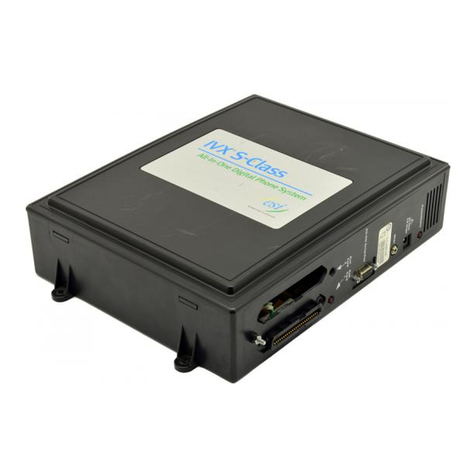
ESI
ESI IVX S-Class Use and care manual

ESI
ESI 55 User manual
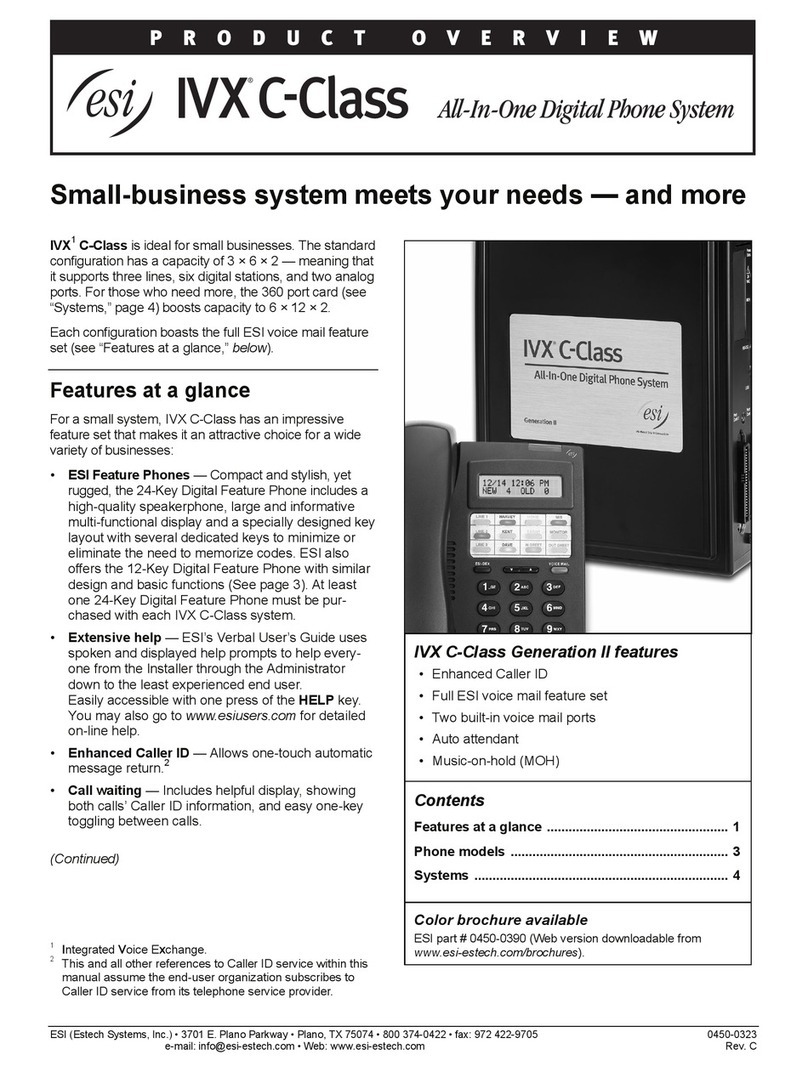
ESI
ESI IVX C-Class Operating and safety instructions
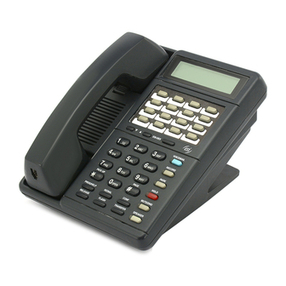
ESI
ESI IVX 20 User manual
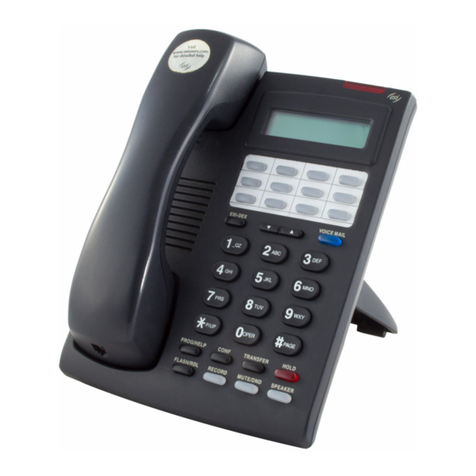
ESI
ESI IVX C-Class User manual

ESI
ESI eSIP Evolution Series User manual
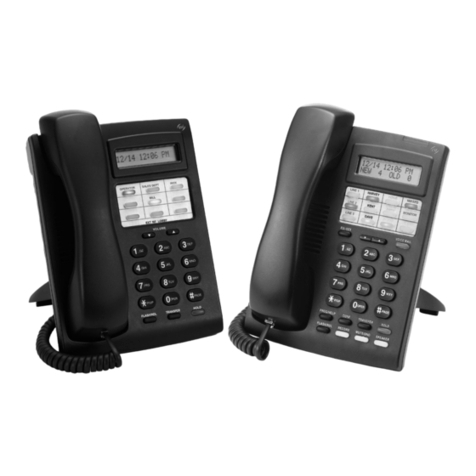
ESI
ESI 12-Key Feature Phone User manual
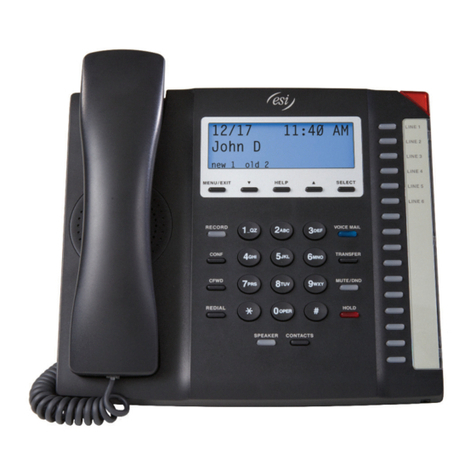
ESI
ESI 45SIP User manual

ESI
ESI ePhoneX eSIP Evolution Series User manual
